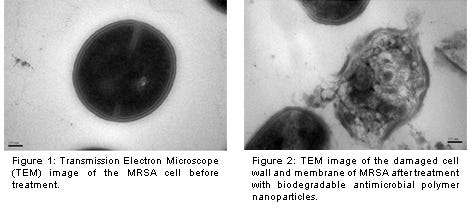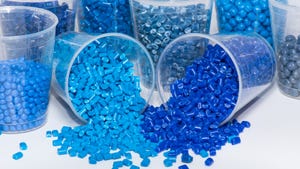A new line of biodegradable polymer nanoparticles can be used to combat drug-resistant bacteria without destroying healthy red blood cells. The antimicrobial polymers inhibit the growth of antibiotic-resistant bacteria without causing hemolysis in the blood, and since low concentrations are required, the polymers do so without promoting significant toxicity.
April 11, 2011
A new line of biodegradable polymer nanoparticles can be used to combat drug-resistant bacteria without destroying healthy red blood cells. The antimicrobial polymers inhibit the growth of antibiotic-resistant bacteria without causing hemolysis in the blood, and since low concentrations are required, the polymers do so without promoting significant toxicity. Developed by scientists at the Institute of Bioengineering and Nanotechnology (IBN) and IBM Research - Almaden, the biodegradable polymers reportedly have "great potential to treat infectious diseases in the body."
Antimicrobial polymer.
To combat so-called "superbugs", like methicillin-resistant staphylococcus aureus (MRSA), researchers have been investigating the use of synthetic polymers with antimicrobial properties for the most effective means of antibiotic delivery. Conventional antibiotics penetrate the microorganisms without damaging the bacteria's cell wall and membrane, and because of this, bacteria can develop resistance against these drugs. Antimicrobial polymers, however, break down the bacterial cell wall and membrane based on electrostatic interaction with the bacteria to prevent drug resistance.
In addition to breaking down the infected cells, however, existing antimicrobial polymers also led to the deterioation of red blood cells. The polymers were also non-biodegradable, limiting their in vivo application since they can't be naturally eliminated from the body.
The researchers reported that the polymer's starting materials are "inexpensive", with a "simple" synthesis that would scalable for future clinical applications. The biodegradable nanoparticles could be topically applied to the skin or injected into the body to treat skin infections. They could also be developed into consumer products, including deodorants, table wipes, and preservatives, or as treatments for wound healing, multidrug-resistant tuberculosis, and lung infection.
The antimicrobial polymers were tested against clinical microbial samples by the State Key Laboratory for Diagnosis and Treatment of Infectious Diseases, First Affiliated Hospital, College of Medicine, Zhejiang University in China. The researchers have filed six U.S. patent applications on the self-assembling synthetic polymers for biomedical applications and published 21 papers on their development.
The global market for infectious disease treatment totaled $90.4 billion in 2009, and is projected to reach $138 billion in 2014, according to BCC Research. The largest market share belongs to antibiotic treatments for bacterial and fungal diseases with 53% of the total infectious disease treatment market. Almost 95,000 people contracted serious MRSA infections and an estimated 19,000 were killed from this hospital stay-related infection in the U.S. in 2005.
About the Author(s)
You May Also Like


